
Summer’s a great time for kids to push away from the keyboard for a bit and engage in some decidedly non-digital activities, but that’s not to say our digital collections can’t be a great starting point.
Beatrix Potter is one of the most popular authors on our Lit2Go audiobook website. Here you’ll find her The Tale of Peter Rabbit, The Tale of Squirrel Nutkin, The Tailor of Gloucester, and sixteen other favorites from the Peter Rabbit collection. While Potter’s tales can make great bedtime stories and can amuse both children and adults on long vacation drives, they also can be used as inspiration for summer activities.
Potter’s stories didn’t just spring out of thin air. They were all rooted in her love of nature, her menagerie of pets, and her interest in farming and gardening. You may like to read more about her life and legacy at the PeterRabbit.com website.
Most of the Beatrix Potter audiobooks on the Lit2Go website are between five and fifteen minutes long, making the goal of listening to all nineteen in one vacation period very doable. Whether you are considering summer reading assignments, homeschooling activities, ideas for camps, or simply family projects, here are a few ideas for extending the Beatrix Potter audiobooks into the real world.
Pet Drawings
As a child, Beatrix Potter spent much of her time making detailed drawings of plants and animals, but especially of her pet rabbits. Her first rabbit was Benjamin Bouncer. Her second rabbit, Peter Piper, accompanied her everywhere. Between Beatrix and her younger brother Bertram, the household included rabbits, mice, frogs, lizards, snakes, and even a bat as pets. Learning to draw or paint well takes unhurried blocks of time for careful observation and experimentation with materials and technique. The summer holidays might be the perfect time to sharpen one’s powers of observation, especially if an obliging pet is available to pose.
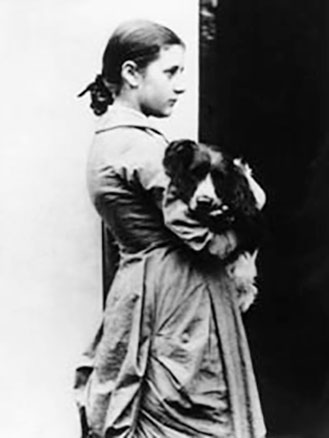
Beatrix at age 15 with dog. Wikimedia Commons.

Illustration from The Tale of Jemima Puddle-Duck. Wikimedia Commons.
Planting an English Garden
While many of Potter’s stories involve vegetable gardens and hungry rabbits, her illustrations also include informal English flower gardens. For children who think a flower garden must consist of evenly-spaced annuals planted with mathematical precision across the front of a house, an Internet search for English garden or English cottage garden will open an entirely new world. Is there a place at home or on school grounds where a proper English garden can be planted? Start with a winding path and add an informal mix of plants. A gate to keep curious rabbits out helps set the mood. Make sure there is a nice place to sit to read, or perhaps listen to Beatrix Potter’s tales on Lit2Go!

Visitors waiting to enter Beatrix Potter’s Hill Top Farm residence with the garden in foreground. Donnylad via Wikimedia Commons.
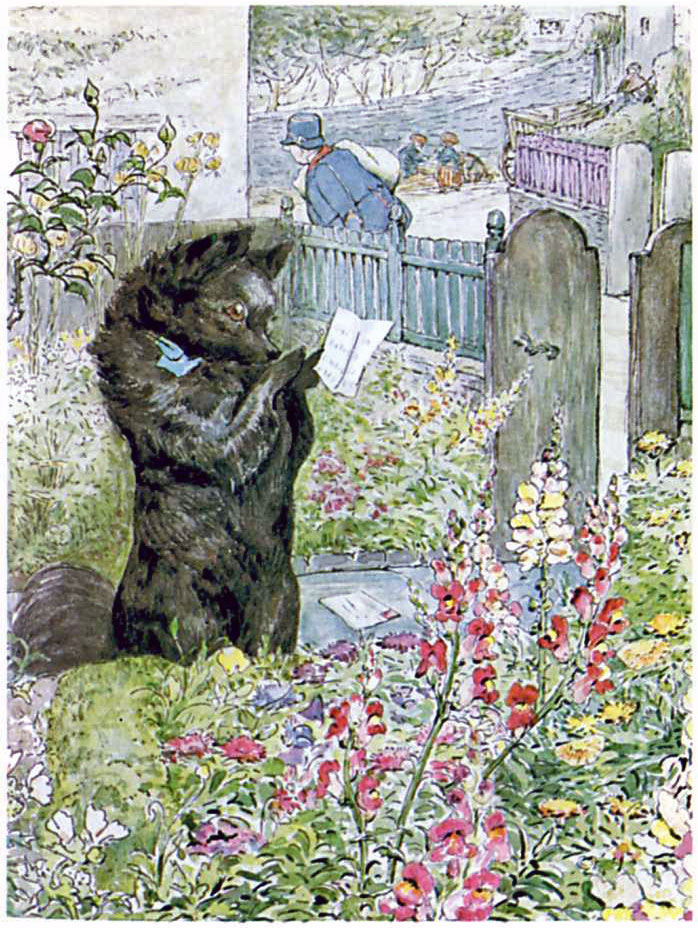
Illustration from The Tale of the Pie and the Patty-Pan. Wikimedia Commons.

Garden path at Hill Top Farm. Peter Trimming via Wikimedia Commons.

Garden where Beatrix Potter wrote and sketched Tales of the Flopsy Bunnies.
MsDinbych via Wikimedia Commons.
Illustrated Letters
Potter’s Peter Rabbit stories all began with an illustrated letter. Noel Moore, the five-year-old son of Potter’s former governess was recovering from a case of scarlet fever. Potter decided to amuse the boy by writing and illustrating a letter about her pet rabbit named Peter. “I don’t know what to write to you, so I shall tell you a story about four little rabbits, whose names were Flopsy, Mopsy, Cottontail, and Peter….” The boy’s mother later suggested that Potter rework the letter into a book and the rest is history. The Tale of Peter Rabbit has sold over 40 million copies worldwide.
For tech-savvy kids today who think even email is an ancient, outmoded form of communication, creating an actual written letter with illustrations may well be a new experience. Try organizing a pen pal project that includes sketches of new activities and experiences during a vacation period.

Illustrated letter with the original idea for Peter Rabbit. Wikimedia Commons.
Botanical Studies
Not every child has a pet and not every pet is willing to sit for a portrait. Plants often make for more compliant models. Beatrix Potter made many plant drawings and paintings, but she was particularly interested in fungi. She made over 300 watercolor paintings of fungi. After her death, the illustrations were given to the Armitt Library and Museum.
A vacation period can be a great time to study and draw plants—perhaps from one’s own garden in the summer. It was about 60 years ago that my parents (and I!) discovered my artistic bent when I spent several days drawing a poinsettia plant over the Christmas holidays. Time and a bit of boredom can lead to great discoveries.

A fungus illustration from 1897 by Beatrix Potter. Wikimedia Commons.
Click any of the thumbnails below to visit the story on the Lit2Go website. Each story includes an audio file, the complete text on a webpage, a PDF of the text, and one or two suggested activities for students. An index to all of the stories is available here.
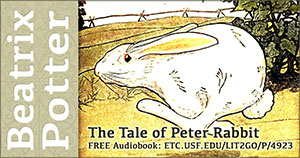
The Tale of Peter Rabbit
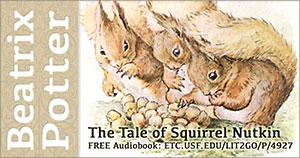
The Tale of Squirrel Nutkin
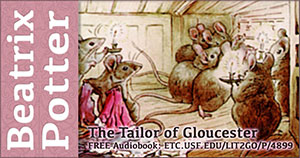
The Tailor of Gloucester

The Tale of Benjamin Bunny

The Tale of Two Bad Mice
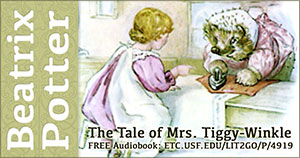
The Tale of Mrs. Tiggy-Winkle
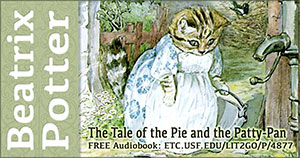
The Tale of the Pie and the Patty-Pan
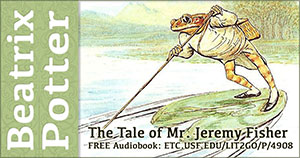
The Tale of Mr. Jeremy Fisher

The Story of a Fierce Bad Rabbit

The Story of Miss Moppet

The Tale of Tom Kitten

The Tale of Jemima Puddle-Duck
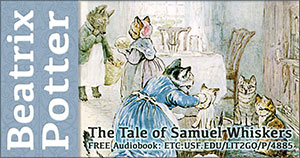
The Tale of Samuel Whiskers or, The Roly-Poly Pudding
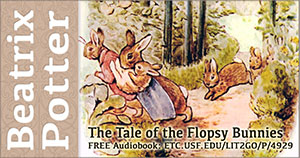
The Tale of the Flopsy Bunnies
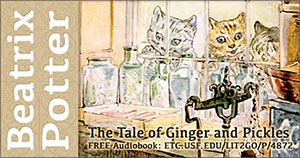
The Tale of Ginger and Pickles
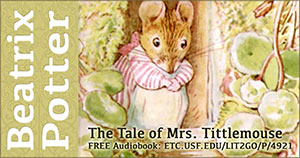
The Tale of Mrs. Tittlemouse

The Tale of Timmy Tiptoes
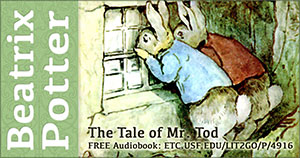
The Tale of Mr. Tod

The Tale of Pigling Bland
Additional Lit2Go Posts
- Lit2Go: Grade 4 Reading Activities for Home and School
- Lit2Go: Grade 5 Reading Activities for Home and School
- Lit2Go: Grade 6 Reading Activities for Home and School
- Lit2Go: Grade 7 Reading Activities for Home and School
- Lit2Go: Grade 8 Reading Activities for Home and School
- Lit2Go: Grade 9 Reading Activities for Home and School
- Lit2Go: Grade 10 Reading Activities for Home and School
- Lit2Go: Grade 11 Reading Activities for Home and School
- Lit2Go: Grade 12 Reading Activities for Home and School
- How To Use Lit2Go Audiobooks in Your Classroom
- Five Reasons To Use Audiobooks for Remote Learning
- Frederick Douglass: A Voice for Our Time
- Lit2Go: The Soundtrack for Your Students’ Next Movie
- African-American Digital Content Collections
- Tales for All: The Lit2Go Folk & Fairy Tale Collection
- Spooky Stuff: Scary Tales from Lit2Go
- Autumn in Verse: Poetry from Lit2Go
- Winter Pictures and Poetry from Lit2Go
- Spring in Verse: Poetry from Lit2Go
- A Beatrix Potter Summer
- April: National Poetry Month
- 39 Recorded Speeches and the Reasons To Use Them with Your Students
- Happy Birthday, William Shakespeare!
Roy Winkelman is a 40+ year veteran teacher of students from every level kindergarten through graduate school. As the former Director of FCIT, he began the Center's focus on providing students with rich content collections from which to build their understanding. When not glued to his keyboard, Dr. Winkelman can usually be found puttering around his tomato garden in Pittsburgh. Questions about this post or suggestions for a future topic? Email me at winkelma@usf.edu. To ensure that your email is not blocked, please do not change the subject line. Thank you!
FCIT Newsletter
Each month FCIT publishes a newsletter with short articles on teaching and learning with technology, using digital content in the classroom, and technology integration. Subscribe today! The subscription form will open in a new window. When you have subscribed, you can close the new window to return to this page.
